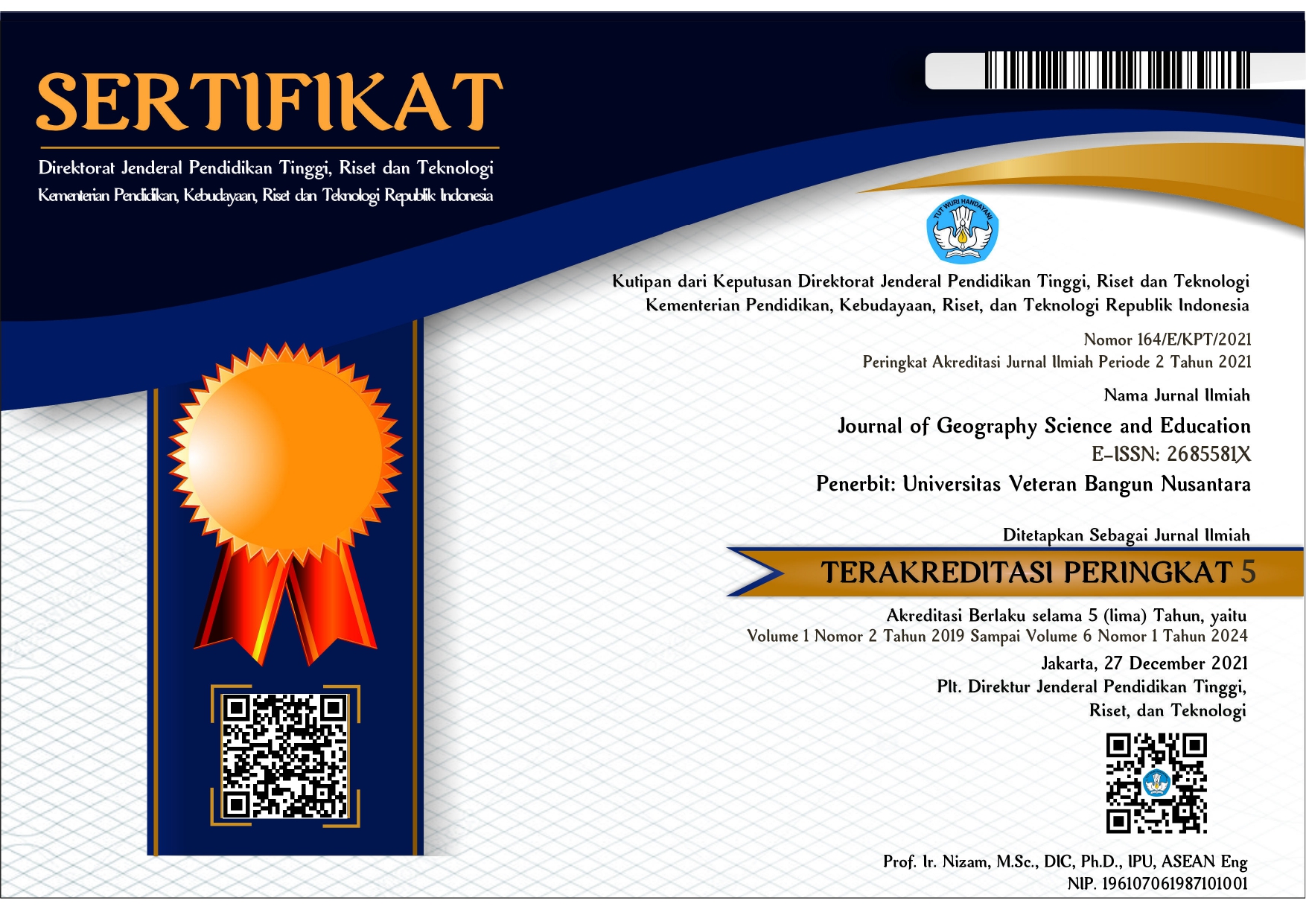DENSITY OF BUILDINGS IN GROGOL DISTRICT SUKOHARJO DISTRICT 2018
DOI:
https://doi.org/10.32585/jgse.v3i1.1514Kata Kunci:
Remote Sensing, Visual Interpretation, Building DensityAbstrak
The objectives of this study were to: (1) determine the number of buildings in Grogol District, Sukoharjo Regency; (2) anlaysis the building density in Grogol District, Sukoharjo Regency. This study uses remote sensing with the Visual Quickbird interpretation method obtained from Google Earth Pro, namely using interpretive elements such as hue / color, shape, texture, and location / association. Visual interpretation is used to determine the number of buildings and building density. The data collection techniques used were image interpretation and field surveys. The data analysis technique used is geographic descriptive, which describes the spatial data analysis. The results of this study were Cemani Village is the village with the highest density of buildings 96.85%, while Parangjoro is the village with the lowest density of buildings with 28.41%.
Unduhan
Referensi
Abdi Sukmono, 2019. Utilization of Landsat Image Hybrid Interpretation In Identification of Building Density for Development Monitoring Ungaran City Area
BPS. 2018. Grogol District in Figures of 2019. Sukoharjo
Mirta Indriastuti, Hani'ah, Abdi Sukmono, 2018. Density Analysis Building Using Hybrid Interpretation of Landsat Satellite Images in East Ungaran and West Ungaran Districts, Semarang Regency 2009-2018. Diponegoro University, Faculty of Engineering
Ratnasari, Dwi Santy, Suharyadi. 2016. Utilization of High Resolution Images Multitemporal for Analysis of Settlement Development Characteristics Bogor City, 2005-2014 Using Spatial Statistics. University Gajah Mada Yogyakarta
Shanti Puspitasari, Suharyadi. 2015. Building Density Study Using a Landsat-8 Oil Hybrid Image Interpretation in Semarang City
Suharyadi. 2011.. Hybrid Interpretation of Spatial Resolution Satellite Images Intermediate for Urban Area Building Density Study in Yogyakarta Urban Area. Gadjah Mada University Yogyakarta
Sunarhadi, MA, Utaya, S., Astina, IK., Budijanto. Learning Media Spatial Thinking: A teaching guide, media, and learning modules geography to develop participants' spatial thinking skills students. — Ed. 1, Cet. 1--, Sukoharjo: Geoinfolit, June 2018
Sutanto. 1986. Remote Sensing Volume 1. Gajah Mada University Yogyakarta
Sutanto. 1992. Remote Sensing. Gajah Mada University Yogyakarta
Unduhan
Diterbitkan
Cara Mengutip
Terbitan
Bagian
Lisensi
License and Copyright Agreement
In submitting the manuscript to the journal, the authors certify that:
- They are authorized by their co-authors to enter into these arrangements.
- The work described has not been formally published before, except in the form of an abstract or as part of a published lecture, review, thesis, or overlay journal. Please also carefully read JGSE's Posting Your Article Policy at http://pubs2.ascee.org/index.php/ijele/about/editorialPolicies#custom-5
- That it is not under consideration for publication elsewhere,
- That its publication has been approved by all the author(s) and by the responsible authorities – tacitly or explicitly – of the institutes where the work has been carried out.
- They secure the right to reproduce any material that has already been published or copyrighted elsewhere.
- They agree to the following license and copyright agreement.
Copyright
Authors who publish with Journal of Geography Science and Education agree to the following terms:
- Authors retain copyright and grant the journal right of first publication with the work simultaneously licensed under a Creative Commons Attribution License (CC BY-SA 4.0) that allows others to share the work with an acknowledgment of the work's authorship and initial publication in this journal.
- Authors are able to enter into separate, additional contractual arrangements for the non-exclusive distribution of the journal's published version of the work (e.g., post it to an institutional repository or publish it in a book), with an acknowledgment of its initial publication in this journal.
- Authors are permitted and encouraged to post their work online (e.g., in institutional repositories or on their website) prior to and during the submission process, as it can lead to productive exchanges, as well as earlier and greater citation of published work.
Licensing for Data Publication
Journal of Geography Science and Education use a variety of waivers and licenses, that are specifically designed for and appropriate for the treatment of data:
- Open Data Commons Attribution License, http://www.opendatacommons.org/licenses/by/1.0/ (default)
- Creative Commons CC-Zero Waiver, http://creativecommons.org/publicdomain/zero/1.0/
- Open Data Commons Public Domain Dedication and Licence, http://www.opendatacommons.org/licenses/pddl/1-0/
Other data publishing licenses may be allowed as exceptions (subject to approval by the editor on a case-by-case basis) and should be justified with a written statement from the author, which will be published with the article.
Open Data and Software Publishing and Sharing
The journal strives to maximize the replicability of the research published in it. Authors are thus required to share all data, code or protocols underlying the research reported in their articles. Exceptions are permitted but have to be justified in a written public statement accompanying the article.
The associated persistent identifiers (e.g. DOI, or others) of the dataset(s) must be included in the data or software resources section of the article. Reference(s) to datasets and software should also be included in the reference list of the article with DOIs (where available). Where no domain-specific data repository exists, authors should deposit their datasets in a general repository such as ZENODO, Dryad, Dataverse, or others.
Small data may also be published as data files or packages supplementary to a research article, however, the authors should prefer in all cases a deposition in data repositories.










